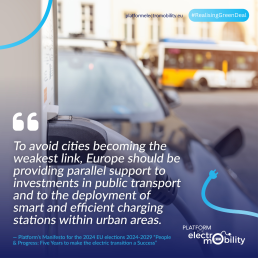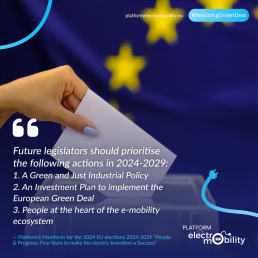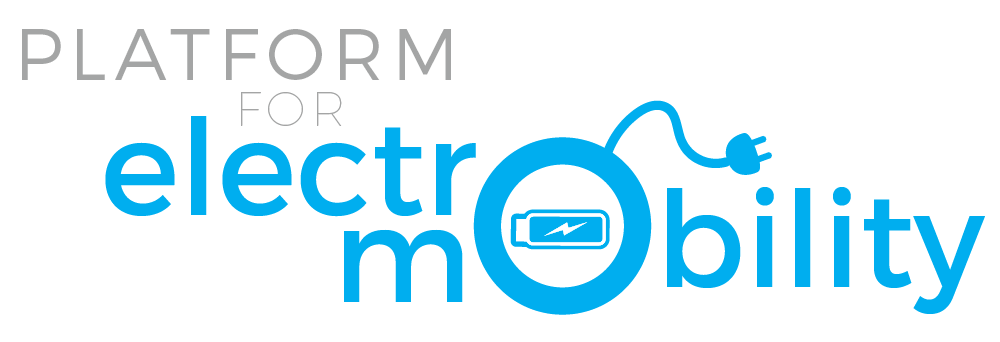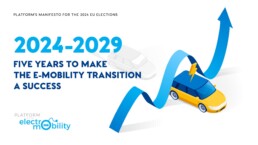Weights and Dimensions Directive: How to accelerate the uptake of zero-emission heavy-duty vehicles
Review of the Weights and Dimensions (W&D) Directive:
How to accelerate the uptake of zero-emission heavy-duty vehicles
In July 2023, the European Commission published the Greening Freight Package with the purpose of making freight more sustainable and efficient. As part of this Package, the review of the Weights and Dimensions (W&D) Directive aims to promote the uptake of electric and hydrogen trucks and buses.
The Commission proposes to increase the weight and length limits of zero-emission (ZE) heavy-duty vehicles. These provisions are intended to ensure ZE trucks don’t have to sacrifice cargo weight on long-haul routes, and ZE buses don’t have to decrease the number of passengers, in comparison to a comparable combustion model. However, the proposal fails to ensure the full application of the ZE weight allowance.
Despite noble intentions, the Commission includes several provisions which would keep the EU anchored to diesel trucks. In particular, the proposals on gigaliners[1] and combustion vehicles of 44 tonnes risk steering investment away from the zero-emission sector. Furthermore, the review should pay more attention to road wear and bridges.
The proposal also needs changes to make it truly intermodal and interoperable with other modes like (electric) rail. Such changes cannot be designed without having a perspective on what the Combined Transport Directive (CTD) will look like. This Directive plays an important role in reducing the carbon footprint of the whole logistic sector. For this reason, and as detailed in the Platform’s recent letter, we ask the European Commission to present the CTD without further delay. As such both proposals can be truly treated “as a package”, as was originally intended.
The need for a review of the W&D Directive
The heavy-duty vehicle (HDV) sector needs to decarbonize rapidly. In the first half of 2023, diesel trucks accounted for 95.6% of newly registered trucks[2]. While trucks account for just 2% of vehicles on the road, they are responsible for nearly 30% of greenhouse gas emissions from road transport in Europe.
Under current policies, this share is set to grow. According to the European Commission, truck activity will increase by about 40% between 2019 and 2050. Over the same period, bus and coach activity is expected to grow to a smaller but still considerable extent (+10%). Although buses are decarbonising much faster – 30% of new urban bus sales in 2022 were ZE – diesel buses still represented 67.3% of the new sales in Europe in 2022[3].
The EU thus needs to rapidly transition to 100% zero-emission HDV sales. As ZE trucks and buses weigh more than their diesel counterparts, a review of the W&D Directive is needed to really incentivise their uptake and set the sector in line with the Union’s goal of climate neutrality by 2050.
Our shared vision
We welcome the Commission’s intention to give zero-emission trucks a 4t weight allowance (as well as 2t to ZE buses). However, co-legislators need to intervene and ensure zero-emission trucks can fully use it, so that it is ensured that under no use case long-haul ZE trucks, which require bigger batteries, would have to sacrifice cargo weight. The proposal severely hampers the application of the ZE allowance, leaving road freight across key national borders (e.g. between France and Belgium) largely to diesel trucks.
The Commission requires the use of the ZE weight allowance for cross-border movement only, underestimating the relevance of national transport. Also, the wording of the Annex risks giving the 4t ZE allowance to diesel tractor units only because they pull electric trailers.
An increase in driving axle weight is essential for long-established truck-makers to switch from making fossil vehicles to electric. However, truck-makers don’t need the proposed 1t increase (from current 11.5 to 12.5t), which also fails to incentivise them to switch to clean sheet designs (lighter, optimised e-trucks).
The proposed regularisation of the cross-border movement of 44t combustion vehicles and of European Modular Systems (so-called gigaliners) brings them out of their current legal grey area. These longer, heavier vehicles will however only achieve real emission reductions if they are zero-emission. Unfortunately, the Commission does not provide any sunset clause for the cross-border movement of fossil gigaliners, nor does it propose a ZE weight allowance for these vehicles, thereby offering no incentive for the use of ZE gigaliners by fleet operators. Extending the use of 44t combustion vehicles and gigaliners risks delaying the take-up of electric vehicles, particularly during the 2020s. Making internal combustion trucks more attractive for long-haul transport also increases the fossil fuel dependency of the European freight sector, and therefore the EU’s dependence on imports.
Intermodal logistics system
Enhancing intermodal logistics in Europe is crucial to reach CO2 reduction objectives. Intermodal compatibility must be ensured throughout the revision process of the W&D Directive (which should not penalise rail freight) and the upcoming Combined Transport Directive.
Therefore, the Platform supports prior assessment for new gigaliner routes / movements so that they do not take traffic from rail or waterway. This prior assessment should also include an analysis of road safety and the need for additional driver training. As Kristian Schmidt, DG MOVE’s land transport director, has noted, reform should not promote truck traffic at the expense of rail, or “we’re in all kinds of political trouble[4].”
The Commission proposes +4t for zero-emission trucks, but fails to ensure its full application. Because of the 44t weight limit, ZE trucks heavier than >40t cannot fully use it (without losing payload). This de facto decreases the ZE incentive. Our recommendation would fully keep it.
The proposal only requires the use of the 4t ZE allowance for cross-border movement. Given the relevance of national freight, it should also be applied within each Member State. Also, co-legislators need to make sure that diesel tractor units just pulling e-trailers do not receive the ZE allowance.
The Commission proposal (1t increase from 11.5 to 12.5t) would increase road wear by ~40%[5]. We propose limiting the increase to 12t, which is enough for manufacturers, and make it conditional on safeguards related to tyres, tyre pressure monitoring and acceleration[6]. The 2029 sunset clause for trucks[7] will incentivise the use of 3-axle tractor units and clean sheet designs (lighter vehicles).
Zero-emission / intermodal gigaliners should be guaranteed the 4t ZE allowance proposed for other vehicle combinations. As well as the 2030 phase-out for diesel, conditionality should cover a prior assessment to avoid reverse modal shift from rail, and analysis for road safety & driving training.
5-axle rigids are short vehicles (max 12m). Currently, their cross-border movement is limited to 32t. The proposal (40t +2t ZE allowance) would damage roads and bridges whereas the recommendation here makes any increase subject to the application of a 2t ZE allowance.
The Platform for electromobility called, in an open letter to Commissioner Valean to urgently present the Combined Transport Directive revision. Read the letter here: https://www.platformelectromobility.eu/wp-content/uploads/2023/11/PfEM_Open-Letter-to-Commissioner-Valean-on-Combined-Transport-Directive.pdf
in order to guarantee a swift (1 year) transposition of rules and enable a rapid upscale of battery-electric trucks in the EU.
[1] Longer and heavier vehicle combination consisting of more modules and with a typical length of 25,25m. [2] ACEA (2023). New commercial vehicle registrations: vans +11.2%, trucks +20%, buses +15% in the first half of 2023. Link. [3] This share decreased to 63% in the first half of 2023. [4] Politico, 29 September 2023. [5] UK Department for Transport (2010). HGV maximum weights. Link. [6] More specifically, wide-base high-efficiency single tyres on the steering axle and a dual tyre configuration on the driving axle; the alert threshold of the Tyre Pressure Monitoring system set at 0.6 bar, rather than current 1.2 bar, with a duty to restore under- or over-inflation at the nearest available facility; an acceleration limiter, with 1.2 m/s2 as a limit. [7] An indicative phase-out date of 2035 should be set for ZE buses.
Open letter
Accelerating the electrification of fleets is key to cut transport emissions and increase affordable electric vehicles for consumers
To European Commission Executive Vice-President for the European Green Deal,
To the European Commissioner for Climate Action,
To the European Commissioner for Transport,
Maroš Šefčovič
Adina-Ioana Vălean
Wopke Hoekstra
Dear,
First of all, we would like to congratulate Mr Šefčovič and Mr Hoekstra with their appointment respectively as Executive Vice-President for European Green Deal, Interinstitutional Relations and Foresight and Commissioner for Climate Action. We look forward to working together with you and supporting you during the upcoming mandate.
EU action to accelerate fleet electrification represents a golden opportunity to not only tackle transport emissions, EU’s largest source of greenhouse gas emissions, but also widen the access to cheaper second-hand electric vehicles. We therefore very much welcome Vice-President Šefčovič’s pledge during last week’s hearing that “By the end of the year, the Commission will launch a public consultation in preparation for future action to accelerate the electrification of corporate fleets by 2030.”
6 out of 10 cars sold in the EU are company cars, with those vehicles driving twice as much as private cars. The purchasing decisions of corporate fleets have far wider implications than just for that enterprise. Company cars tend to spend 3 to 5 years in a fleet before going into the used car market. With 8 out of 10 Europeans buying their cars in the used car market, this is a crucial channel for EU citizens.
Accelerating the transition towards electric vehicles beyond existing policies is a necessity to achieve transport’s net-zero and the 2040 climate target of -90%. As such, the faster fleets electrify their company cars, the faster more households will be able to access more affordable electric vehicles powered by clean European electricity, the faster we can reduce transport emissions. This is a win-win for climate and consumers.
Corporate fleets are in a great position to lead the way on electrification, with many already committed to fully transitioning their fleets by the end of the decade through Climate Group’s EV100 campaign. On a total cost of ownership basis, electric vehicles have the advantage over polluting vehicles meaning electrification makes strong business sense too. A regulatory framework would simply ensure that all fleets are playing their part.
That’s why the Platform for electromobility – the alliance of uniting automotive industries, NGOs, civil society and cities, the Europe’s leading consumer association and the leading global initiative bringing together fleets committed to electrification – are uniting and calling on you to:
- Deliver on your promise to launch a public consultation by the end of this year at the very latest.
- Limit the scope of the public consultation to legislative options to accelerate fleets electrification of at least 95% by 2030.
- Include light commercial vehicles in the scope of this public consultation.
- As part of this consultation come forward with a timeline for a swift adoption of this legislation.
We hereby reiterate that we fully support the European Commission in setting binding zero emission purchase targets for corporate fleet (passenger cars) of minimum 65% in 2027 and 95% in 2030 and binding electrification targets for light commercial vehicles.
We would very much appreciate a meeting where we can discuss this initiative. We count on your leadership to bring forward a public consultation.
With kind regards,

13th October 2023
Recommendations to trilogue negotiators on EPBD
EPBD Trilogue
Our recommendations to negotiators
In 2023, battery electric vehicle (EV) sales reached a milestone, accounting for 15% of total sales in the European automotive market. At the same time, about 25% of bicycles sold are e-bikes. These positive trends are expected to continue, driven by ambitious EU objectives and legislations and national recovery plans.
To ensure the success of Europe’s transition to zero-emission mobility, the deployment of private charging infrastructure is of utmost importance, given that 75% of all charging takes place at home or in the workplace. While the EPBD consider the upcoming needs of electromobility, we believe that safeguarding the strongest agreements are needed to establish the right conditions for widespread EV adoption.
The Platform for electromobility fully supports the revision of the EPBD, particularly the introduction of Article 12, which focuses on electromobility infrastructure in buildings. We commend to preserve provisions that guarantee a strong and coherent right to plug in all buildings, remove regulatory barriers, and require smart charging-readiness for new and renovated chargers, among other measures.
As the EU institutions start trilogue talks, it’s clear the European Parliament wants more than the Council. But the many exceptions for installing infrastructure could make things confusing and inconsistent across Europe, we would like to present five additional recommendations:
- Clarify the scope of application of Art 12
The current wording could be interpreted restrictively. We seek clarification to ensure that requirements apply to parking spaces both adjacent to and inside buildings.
- Ensure charging solutions in existing buildings
Given that a significant portion of existing buildings will remain in use by 2050, we propose extending the scope of Article 12 to require clear and transparent rules for EV charging points in existing buildings. Incentives and compliance mechanisms should be introduced.
- Complete charging requirements for new and renovated buildings
Extend requirements to cover depots, logistic hubs, and distribution centres, ensuring they are ready for future EV charging.
- Reinforce smart charging functionalities
Mandate that all newly installed chargers in buildings are capable of smart charging. Ensure consistency in definitions and provisions with related regulations and recognize the value of mobile storage.
- Reinforce measures to ensure pre-cabling
Provide an explicit definition of pre-cabling, inform about readiness in Energy Performance Certificates, and simplify permit and installation procedures. Address administrative hurdles and encourage Member States to financially support EV charging installations.
- Ensure adequate bicycle parking:
Opt for bicycle parking to represent 15 % of total user capacity in non-residential buildings, and with space required also for bicycles with larger dimensions than standard bicycles.
- Reject opt outs for SMEs
98% of all commercial enterprises are SMEs, therefore the Directive would no longer apply to 98% of commercial non-residential buildings. This is a tool that is too moderate.
- Re-ensure provision on Right-to-plug
The Right-to-plug lowered since in point 8 both co-legislators mentioned a “request by tenants or co-owners to install CPs can only be refused if there are serious reasons for doing so”. This could weaken provision on Right-to-plug, giving the possibility to landlords and condominium assemblies to refuse the Right-to-plug and install a charging infrastructure in not so clarified cases. We call to remove or clarify the point 8.
- Preserving precabling
In contrast to prevailing targets, where the European Commission’s proposal advocates for 100% precabling, the Council suggests a balanced approach of 50% precabling and 50% ducting. Additionally, in the case of new and renovated residential buildings, the Parliament recommends a complete shift towards 100% ducting if 100% precabling is deemed unfeasible. However, we propose retaining the precabling targets in alignment with the European Commission’s proposal. This approach ensures the preservation of cost-efficiency in future installations and reinforces the fundamental right to access plug-in infrastructure.
Now, it’s crucial for policymakers to act and make sure that every European can charge their electric vehicles at home and work, be it an EV or an e-bike. This is where most EV charging happens already. By doing this, we can make EV charging available to everyone and fully harness the environmental benefits it offers, contributing to the development of an energy system powered by renewables.
2024 Election Manifesto
PLATFORM’S MANIFESTO FOR THE 2024 EU ELECTIONS
2024-2029: Five Years to make the e-mobility transition a Success
The agreement to pursue zero emissions for Europe’s new cars and vans by 2035 backed up by strong charging infrastructure and development of alternatives such as rail network, and the sustainable batteries regulation, has set a clear direction and an unequivocal target for sustainable transport measures.
However, in order to make the Green transition a reality, and bring its benefits to people, the planet and business, it is vital that we act now. Making the transition to e-mobility must be a priority, not simply to deliver environmental sustainability but also to reinforce the EU’s industrial strength, security and competitiveness.
Time to put the Green Deal into action
● The support of the legislative efforts and ambitions of the EU Green Deal and notably The agreement to pursue zero emissions for Europe’s new cars and vans.
● Now it is time to implement those ambitions to reduce Europe’s dependency of fossil fuels, make it a global leader in the sustainable transport industries and priorities quality of life and workspace for Europeans.
● An effective green industrial policy will bring the benefits of Europe’s Green Deal to all.

1st Pillar
A Green and Just Industrial Policy
● Creating an integrated recycling industry ecosystem in Europe.
● Smartening and upgrading existing grid infrastructure to allow it to support greater levels of renewable energy.
● Ensuring strong end-of-life vehicles regulation, focused on low carbon and recycled materials.
2nd Pillar
Investment Plan to implement the Green Deal
● Making it easier for green energy transition sectors to access current EU funding mechanisms.
● Deploying infrastructures to support zero-emission passenger and freight transport across Europe.
● Introducing a dedicated budget for urban nodes, to avoid cities becoming a weak link.


3rd Pillar
People at the heart of the e-mobility ecosystem
● Supporting reskilling programmes to attract workers from traditional industrial sectors and aiding their transition into these emerging sectors.
● Enabling Vehicle-to-Grid (V2G).
● Mandating electric vehicle adoption in corporate fleets.
"It’s time to look ahead and see how the next legislative mandate can put the Green Deal into action. The agreement to pursue zero emissions for Europe’s new cars by 2035 has set a clear direction but this trajectory now needs to be implemented right."
— Julia Poliscanova, Vice-Chair Platform for electromobility
EU Election Manifesto: People at the heart of the e-mobility ecosystem
Manifesto Third Pillar
People at the heart of
the E-mobility ecosystem

As Europe shifts to a green economy, the demand for workers in industries such as critical raw materials, batteries and renewable energy industries will grow. Therefore, it will be essential to allocate EU resources and support to help steer young people into those technical fields essential for the green transition. There should be communication campaigns aimed at raising the visibility – and value – of these technical fields. It will also be crucial to implement well-funded reskilling programmes that will attract workers away from existing traditional industrial sectors and into emerging sectors such as renewable energy, grid management, infrastructures and recycling. These programmes will upgrade workers’ skills, train future workforces and ensure a just transition for the workers, their employers, and regional authorities.
The wider adoption of electric vehicles and rooftop photovoltaic solutions offer significant opportunity to unleash ‘prosumer potential’ in Europe. Restructuring Europe’s electricity market will allow us to maximise this potential, specifically through creating opportunities for Vehicle-to-Grid (V2G) where appropriate. This would enable EV drivers to take an active part to the transition by supplying power back to the grid. Allowing them to be rewarded for providing additional grid capacity and thus making the energy system more dynamic and resilient.
It is critical that zero-emission mobility is affordable to everyone. To that end, both old and new electric mobility solutions must be scaled up across Europe: Existing facilities include public transport offerings, shared cars and e-bikes for situations where individual cars are unnecessary. When they are unavoidable, newer solutions include low-cost leasing options, targeted purchase incentives policies and industrial strategies that support the deployment of smaller, more-efficient battery models should be provided. The rapid uptake of electric vehicles within corporate fleets will accelerate their second-hand availability. Implementing the Climate Social Fund should help drive this transition with the least possible impact on lower income families.

EU Election Manifesto: Investment Plan to Implement the Green Deal
Manifesto Second Pillar
An Investment Plan
to Implement the Green Deal

The 2023 Net Zero Industrial Act and the Critical Raw Materials Act needs an accompanying European Net-Zero Infrastructure Investment Plan. A long-term, easy-to-access investment facility – aimed at sectors key to Net Zero – should be a core issue during the European elections.
Freight and logistics infrastructure are a vital component in the movement of goods within Europe. There should be comprehensive investment in developing and deploying sustainable logistics infrastructure. The key elements for decarbonising freight in Europe while remaining competitive are the roll-out of high-power charging infrastructure required for deploying electric trucks of all ranges, the completion of a high quality, interoperable rail network with very high-speed connections, while ensuring a level playing field with other non-emitting modes of transport of goods.
Europe must also improve support for urban transport. Cities are working to accelerate the modal shift and to increase the electrification of their vehicle fleets. To avoid cities becoming the weakest links Europe should be providing parallel support to investments in zero-emission public transport networks and to the deployment of smart and efficient charging infrastructure within urban areas. To support the required local infrastructure investments, the next Connecting Europe Facility (CEF) transport programme should include a dedicated budget for urban nodes, building upon the experience of the Alternative Fuel Infrastructure Facility. Further support from EU research and innovation programmes as well as guidance, will also be needed to overcome challenges such as the constraint of public space, uneven distribution of private investments in EV charging infrastructure in cities or their integration in multimodal hubs, as well as lack of grid capacity.
Net Zero Sectors include the sustainable mining, processing and recycling of critical minerals and metals, modernising power grids and facilities for industrial material recovery as well as renewable energy production. Although existing European funds could contribute significantly, prioritising access to the current EU funding mechanisms and tailoring them to the specific needs of the sustainable transports value chain participants is essential.

EU Election Manifesto: A Green and Just Industrial Policy
Manifesto First Pillar
A Green and Just
Industrial European Policy

One of the richest ‘urban mines’ available to Europe is the supply of old batteries and other waste materials. By investing in integrated recycling and repurposing facilities for collecting, dismantling, recovering or reusing valuable metals from batteries, Europe can, by 2040, secure a large share of the metal resources it needs for battery production. Such an approach not just reduces waste, it is also scalable, preserving and reusing precious raw materials and keeping a greater proportion of them within Europe, increasing our strategic autonomy.
The overall concept of Europe keeping potentially valuable waste within its borders is one that should be widely adopted. Environmental recycling standards vary; exporting waste for processing to locations without equivalent standards undermines our own attempts to reduce environmental impacts. The EU should encourage recycling by establishing a harmonised approach to the intra-EU shipment of spent batteries. All. Executed properly, this can make Europe competitive in battery recycling, ensure the highest environmental standards and help create a flourishing recycling industry in the future
Resilient, affordable renewable energy will be key to a successful industrial policy; however, this demands that the correct grid assets are in place. With a European Grids Package, Europe can refresh and upgrade its infrastructure to meet the demand to accommodate higher levels of renewable energy. Although this will require investment, doing so will allow Europe to tap into its future grid asset – electric vehicles. It will accelerate the connection of chargers and other Green Deal enabling technologies and allow Europe to tap into the huge energy storage potential offered by electric vehicles.
Europe must also go further than simply reducing vehicle engine emissions; it needs a more-holistic approach to reducing the environmental footprint of all road vehicles. This means decarbonising manufacturing materials, increasing manufacturing efficiency and maximising the circularity of the materials used. Introducing digital product passports, revamping EU products policy to reduce environmental footprints and committing to deliver a strong end-of-life vehicles regulation based on low carbon and recycled materials, will be the key drivers for such change in the years ahead.
Finally, while a renewed European industrial policy has focused on key components and sub-systems, it is important that it considers the full scope of the mobility industries’ value chains supporting their global competitiveness as they address the green transitions.

EU Election Manifesto: Introduction
Manifesto introduction
Now is time to
put Green Deal into action

The agreement to pursue zero emissions for Europe’s new cars and vans by 2035 has set a clear direction and an unequivocal target for sustainable transport measures; with the last legislative session providing backing for the European Green Deal. We fully back these efforts, and urge support through enhancements to the existing charging infrastructure, the development of alternatives such as a strong rail network and a sustainable batteries value chain.
However, in order to make the Green transition a reality, and bring its benefits to people, the planet and business, it is vital that we act now. Making the transition to e-mobility must be a priority, not simply to deliver environmental sustainability but also to reinforce the EU’s industrial strength, security and competitiveness.
Now is the time to put the Green Deal into action
The Green Deal, its technologies and fully electric transport modes will significantly reduce Europe’s dependency on fossil fuels. Recent geopolitical events have shown the importance of ensuring energy security and resource independence.
The Green Deal will also make the EU a global leader in the sustainable transport industries. It will position Europe as an authoritative voice on the need for climate change action while bringing welcome economic growth and the creation of high-quality jobs.
The Green Deal will allow Europe to prioritise the quality of life of its current and future workforce. This will see the highest social standards put in place to protect the interests and livelihoods of Europe’s workers, both now and as part of a sustainable future.
An effective green industrial policy will bring the benefits of Europe’s Green Deal to all.
Continuing and rapid decarbonisation is crucial: but it must be done in such a way that preserves Europe’s competitiveness. Nowhere is this more important than in transport and mobility. The Platform for electromobility – an alliance of companies, cities and NGOs – brings the knowledge and expertise to make an effective and efficient mobility transition a reality.







